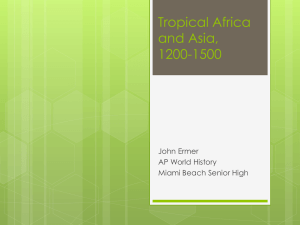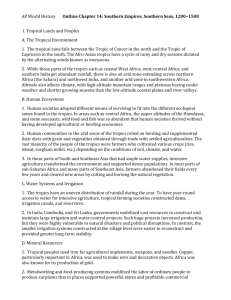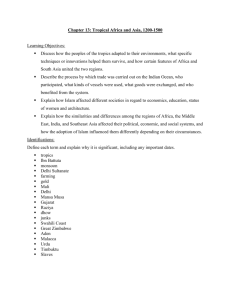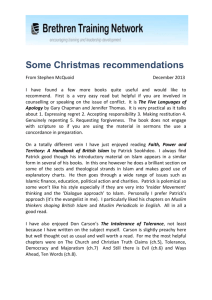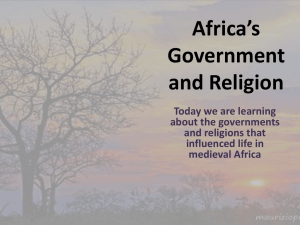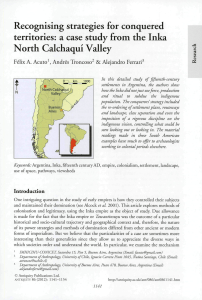I. Tropical Africa and Asia A. The Tropical Environment 1. The
advertisement
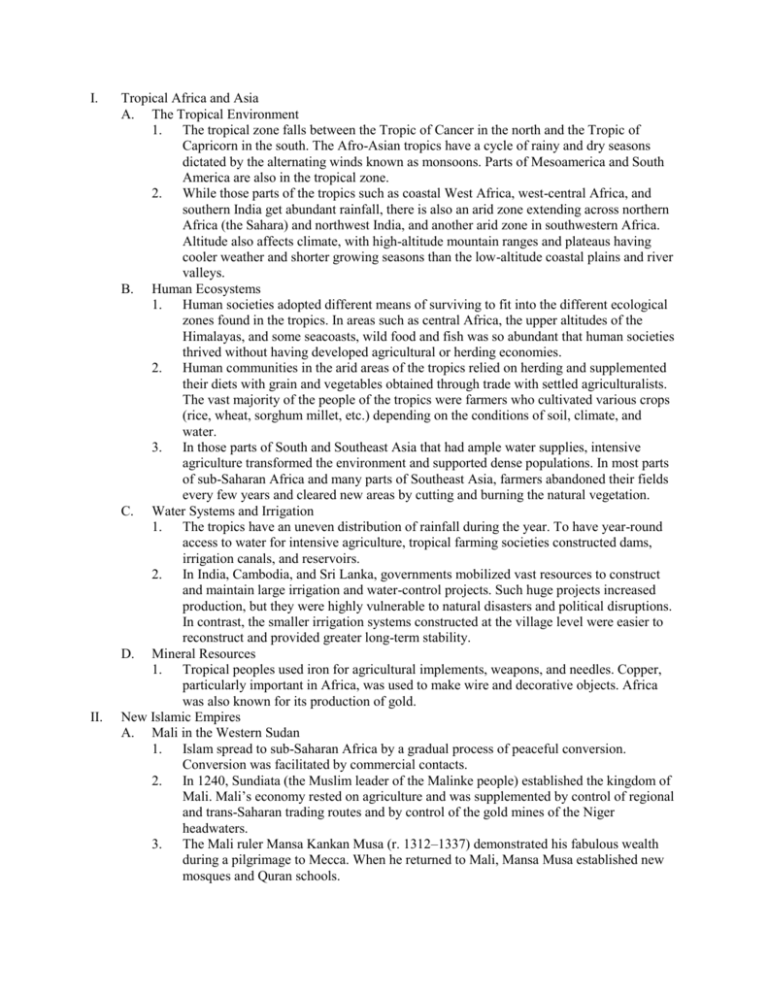
I. II. Tropical Africa and Asia A. The Tropical Environment 1. The tropical zone falls between the Tropic of Cancer in the north and the Tropic of Capricorn in the south. The Afro-Asian tropics have a cycle of rainy and dry seasons dictated by the alternating winds known as monsoons. Parts of Mesoamerica and South America are also in the tropical zone. 2. While those parts of the tropics such as coastal West Africa, west-central Africa, and southern India get abundant rainfall, there is also an arid zone extending across northern Africa (the Sahara) and northwest India, and another arid zone in southwestern Africa. Altitude also affects climate, with high-altitude mountain ranges and plateaus having cooler weather and shorter growing seasons than the low-altitude coastal plains and river valleys. B. Human Ecosystems 1. Human societies adopted different means of surviving to fit into the different ecological zones found in the tropics. In areas such as central Africa, the upper altitudes of the Himalayas, and some seacoasts, wild food and fish was so abundant that human societies thrived without having developed agricultural or herding economies. 2. Human communities in the arid areas of the tropics relied on herding and supplemented their diets with grain and vegetables obtained through trade with settled agriculturalists. The vast majority of the people of the tropics were farmers who cultivated various crops (rice, wheat, sorghum millet, etc.) depending on the conditions of soil, climate, and water. 3. In those parts of South and Southeast Asia that had ample water supplies, intensive agriculture transformed the environment and supported dense populations. In most parts of sub-Saharan Africa and many parts of Southeast Asia, farmers abandoned their fields every few years and cleared new areas by cutting and burning the natural vegetation. C. Water Systems and Irrigation 1. The tropics have an uneven distribution of rainfall during the year. To have year-round access to water for intensive agriculture, tropical farming societies constructed dams, irrigation canals, and reservoirs. 2. In India, Cambodia, and Sri Lanka, governments mobilized vast resources to construct and maintain large irrigation and water-control projects. Such huge projects increased production, but they were highly vulnerable to natural disasters and political disruptions. In contrast, the smaller irrigation systems constructed at the village level were easier to reconstruct and provided greater long-term stability. D. Mineral Resources 1. Tropical peoples used iron for agricultural implements, weapons, and needles. Copper, particularly important in Africa, was used to make wire and decorative objects. Africa was also known for its production of gold. New Islamic Empires A. Mali in the Western Sudan 1. Islam spread to sub-Saharan Africa by a gradual process of peaceful conversion. Conversion was facilitated by commercial contacts. 2. In 1240, Sundiata (the Muslim leader of the Malinke people) established the kingdom of Mali. Mali’s economy rested on agriculture and was supplemented by control of regional and trans-Saharan trading routes and by control of the gold mines of the Niger headwaters. 3. The Mali ruler Mansa Kankan Musa (r. 1312–1337) demonstrated his fabulous wealth during a pilgrimage to Mecca. When he returned to Mali, Mansa Musa established new mosques and Quran schools. 4. The kingdom of Mali declined and collapsed in the mid- to late fifteenth century because of rebellions from within and attacks from without. Intellectual life and trade moved to other African states, including the Hausa states and Kanem-Bornu. B. The Delhi Sultanate in India 1. Between 1206 and 1236, the divided states of northwest India were defeated by violent Muslim Turkish conquerors under the leadership of Sultan Iltutmish, who established the Delhi Sultanate as a Muslim state. Although the Muslim elite then settled down to rule India relatively peacefully, there remained some tension between themselves and their Hindu subjects. 2. Iltutmish passed his throne on to his daughter, Raziya. Raziya was a talented ruler, but she was driven from office by men unwilling to accept a female monarch. Under Ala-uddin (r. 1296–1316) and Muhammad ibn Tughluq (r. 1325–1351), the Delhi Sultanate carried out a policy of aggressive territorial expansion that was accompanied (in the case of Tughluq) by a policy of religious toleration toward Hindus—a policy that was reversed by Tughluq’s successor. 3. In general, the Delhi sultans ruled by force and exaction of revenue. In the midfourteenth century, internal rivalries and external threats undermined the stability of the sultanate. The sultanate was destroyed when Timur sacked Delhi in 1398. It did nevertheless leave a significant legacy in creating a centralized political authority in India and securing a permanent place for Islam there too. III. Indian Ocean Trade A. Monsoon Mariners 1. The Indian Ocean trade increased between 1200 and 1500, stimulated by the prosperity of Europe, Asia, and African and Southeast Asian states. 2. In the Red and Arabian Seas, trade was carried on dhows. From India on to Southeast Asia, junks dominated the trade routes. 3. Junks were technologically advanced vessels, having watertight compartments and up to twelve sails, and carrying cargoes of up to 1,000 tons. Junks were developed in China, but during the fifteenth century, junks were also built in Bengal and Southeast Asia and sailed with crews from those places. 4. The Indian Ocean trade was decentralized and cooperative, with various regions supplying particular goods. In each region, a certain port functioned as the major emporium for trade in which goods from smaller ports were consolidated and shipped onward. B. Africa: The Swahili Coast and Zimbabwe 1. By 1500, there were thirty or forty separate city-states along the East African coast participating in the Indian Ocean trade. The people of these coastal cities, the Swahili people, all spoke an African language enriched with Arabic and Persian vocabulary. 2. Swahili cities, including Kilwa, were famous as exporters of gold that was mined in or around the inland kingdom whose capital was Great Zimbabwe. 3. Great Zimbabwe’s economy rested on agriculture, cattle herding, and trade. The city declined due to an ecological crisis brought on by deforestation and overgrazing. C. Arabia: Aden and the Red Sea 1. Aden had enough rainfall to produce wheat for export and a location that made it a central transit point for trade from the Persian Gulf, East Africa, and Egypt. Aden’s merchants prospered on this trade and built what appeared to travelers to be a wealthy and impressive city. 2. In general, a common interest in trade allowed the various peoples and religions of the Indian Ocean Basin to live in peace. Violence did sometimes break out, however, as when Christian Ethiopia fought with the Muslims of the Red Sea coast over control of trade. D. India: Gujarat and the Malabar Coast 1. The state of Gujarat prospered from the Indian Ocean trade, exporting cotton textiles and indigo in return for gold and silver. Gujarat was not simply a commercial center; it was also a manufacturing center that produced textiles, leather goods, carpets, silk, and other commodities. Gujarat’s overseas trade was dominated by Muslims, but Hindus also benefited. 2. Calicut and other cities of the Malabar Coast exported cotton textiles and spices and served as clearing-houses for long-distance trade. The cities of the Malabar Coast were unified in a loose confederation whose rulers were tolerant of other religious and ethnic groups. E. Southeast Asia 1. The Strait of Malacca is the principal passage from the Indian Ocean to the South China Sea. In the fourteenth century, a gang of Chinese pirates preyed upon the strait, nominally under the control of the Java-based kingdom of Majapahit. 2. In 1407, the forces of the Ming dynasty crushed the Chinese pirates. The Muslim ruler of Malacca took advantage of this to exert his domination over the strait and to make Malacca into a major port and a center of trade. IV. Social and Cultural Change A. Architecture, Learning, and Religion 1. Commercial contacts and the spread of Islam led to a variety of social and cultural changes in which local cultures incorporated and changed ideas, customs, and architectural styles from other civilizations. African and Indian mosques are good examples of the synthesis of Middle Eastern and local architectural styles. 2. In the field of education, the spread of Islam brought literacy to African peoples who first learned Arabic and then used the Arabic script to write their own languages. In India, literacy was already established, but the spread of Islam brought the development of a new Persian-influenced language (Urdu) and papermaking technology. 3. As it spread to Africa, India, and Southeast Asia, Islam also brought with it the study of Islamic law and administration and Greek science, mathematics, and medicine. Timbuktu, Delhi, and Malacca were two new centers of Islamic learning. 4. Islam spread peacefully; forced conversions were rare. Muslim domination of trade contributed to the spread of Islam as merchants attracted by the common moral code and laws of Islam converted and as Muslim merchants in foreign lands established households and converted their local wives and servants. The Islamic destruction of the last center of Buddhism in India contributed to the spread of Islam in that country. 5. Islam brought social and cultural changes to the communities that converted, but Islam itself could be changed, even if only temporarily in African, Indian, and Indonesian societies. B. Social and Gender Distinctions 1. The gap between elites and the common people widened in tropical societies as the wealthy urban elites prospered from the increased Indian Ocean trade. 2. Slavery increased in both Africa and India. An estimated 2.5 million African slaves were exported across the Sahara and the Red Sea between 1200 and 1500, while more were shipped from the cities of the Swahili coast. 3. Most slaves were trained in specific skills; in some cases, hereditary military slaves could become rich and powerful. Other slaves worked at hard menial jobs like copper mining, while others, particularly women, were employed as household servants and entertainers. The large number of slaves meant that the price of slaves was quite low. 4. While there is not much information on possible changes in the status of women in the tropics, some scholars speculate that restrictions on women were eased somewhat in V. Hindu societies. Nonetheless, early arranged marriage was the rule for Indian women, and they were expected to obey strict rules of fidelity and chastity. 5. Women’s status was generally determined by the status of their male masters. However, women did practice certain skills other than child rearing. These included cooking, spinning, pottery making, and clothing production. 6. It is difficult to tell what effect the spread of Islam might have had on women. It is clear that in some places, such as Mali, Muslims did not adopt the Arab practice of veiling and secluding women. The Western Hemisphere A. The Aztecs 1. The Aztecs were originally a northern people with a clan-based social organization. They migrated to the Lake Texcoco area, established the cities of Tenochtitlan and Tlatelolco around 1325, and then developed a monarchical system of government. 2. Gender division of labor was distinct yet complementary. Though warfare increased male power, females maintained control over household and market, and worked both as teachers and priestesses. 3. The kings increased their wealth and power by means of territorial conquest. As the Aztec Empire increased in size, commoners lost their ability to influence political decisions and inequalities in wealth grew more severe. 4. The Aztecs increased agricultural production in the capital area by undertaking land reclamation projects and constructing irrigated fields and chinampas. Nonetheless, grain and other food tribute met nearly one-quarter of the capital’s food requirements. 5. Merchants who were distinct from and subordinate to the political elite controlled longdistance trade. The technology of trade was simple: no wheeled vehicles, draft animals, or money was used. Goods were carried by human porters and exchanged through barter. 6. The Aztecs worshiped a large number of gods, the most important of whom was Huitzilopochtli, the Sun god. Huitzilopochtli required a diet of human hearts, which were supplied by human sacrifice that increased through time. B. The Inka 1. The Inka were a small chiefdom in Cuzco until their leaders consolidated political authority and began a program of military expansion in the 1430s. By 1525, the Inka had constructed a huge empire. 2. The key to Inka wealth was their ability to develop a strong military and to use it to broaden and expand the traditional exchange system that had linked the various ecological zones of the Andes region together. The Inka used the mit’a labor system to form their armies; build their capital city; maintain their religious institutions; and provide for the old, the weak, and the ill. 2. The Inka generally left local rulers in place, controlling them by means of military garrisons and by taking their heirs to Cuzco as hostages. At the central level, the Inka created an imperial bureaucracy led by a king. Each king was required to prove himself by conquering new territory. 4. The capital city of Cuzco was laid out in the shape of a puma, and its buildings were constructed of stone laid together without mortar. Cuzco’s palaces and richly decorated temples were the scene of rituals; feasts; and sacrifices of textiles, animals, other tribute goods, and the occasional human. 3. The cultural attainments of the Inka Empire include astronomical observation, weaving, copper and bronze metallurgy, and gold and silver working. They did not rely on extensive record-keeping but did keep track of bureaucratic records such as tribute with a system of knotted cords called khipus. The Inka did not introduce new technologies but made more efficient use of existing technology to increase the profits gained by the trade among the ecological zones of the Andean region. 4. Inka domination resulted in increased wealth but also in reduced levels of local autonomy. When the elite fell into civil war in 1525, Inka control over its vast territories was weakened. VI. Conclusion A. Between 1200 and 1500 commerce, politics and cultural exchange drew tropical Africa and Asia into a much closer relationship. B. Trade and imperial expansion enlarged the role of Islam in these regions, but many local social and cultural practices either remained stable or found ways of accommodating Islam within them. C. The Aztec and Inca Empires shared similarities in the use of powerful armies, strong economies based on large workforces, and their dependence on organized government and religious practices that connected secular rulers to the gods.
